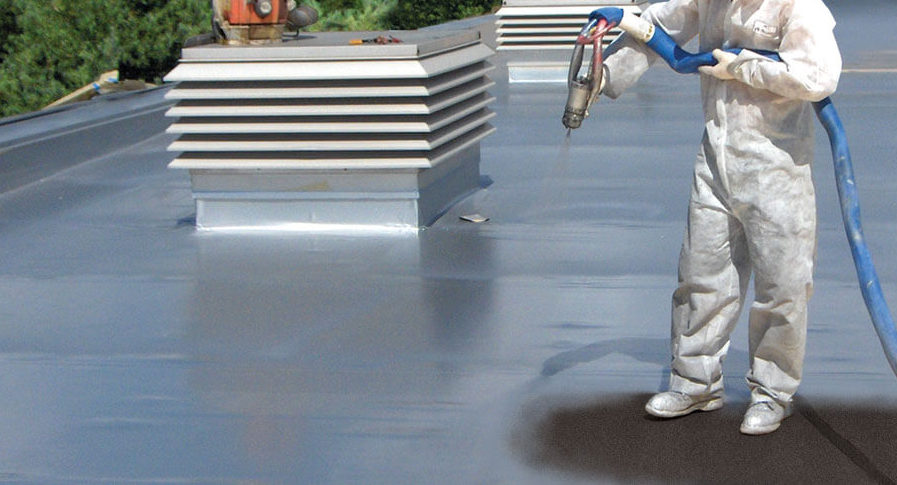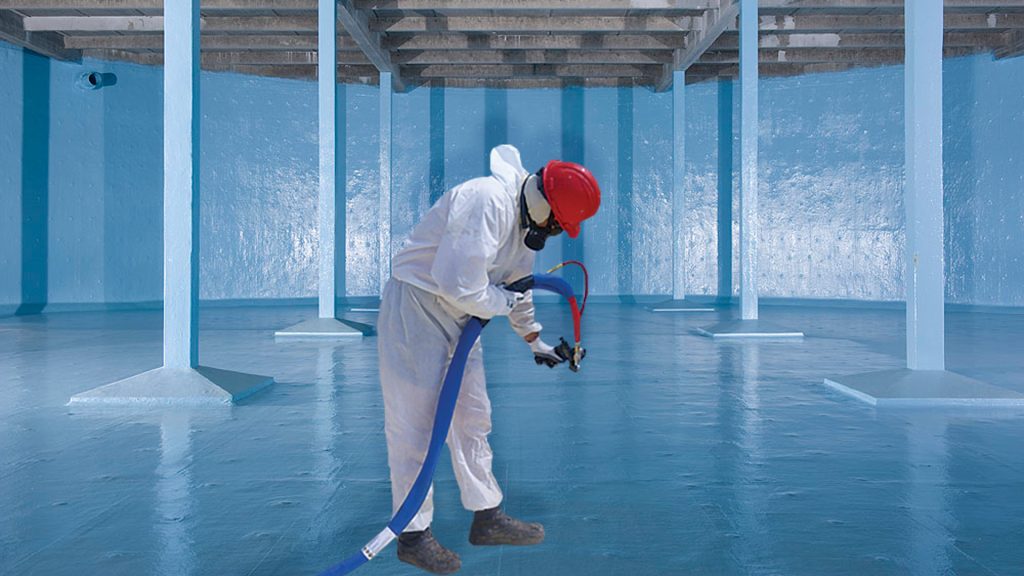Applying a polyurea coating in the presence of moisture can lead to a range of problems – from foaming and bubbles to poor adhesion. Moisture is problematic because it reacts chemically with the isocyanate component – one of two main reaction components – interfering with polymerization. Even though polyurea is often touted as more moisture-tolerant than polyurethane, excess water during spraying or curing can still cause defects like blisters, pinholes, and delamination. But to understand why, we need to look at what happens on a chemical level when water is present in a polyurea system.
THE ISOCYANATE–WATER REACTION
Isocyanates are highly reactive not just with amines (what you want them to react with) but also with water (most certainly not what you want them to react with). If water is available, such as from humid air, a damp substrate, or residual surface moisture, the isocyanate will react with it to form an unstable carbamic acid, which immediately decomposes into a primary amine and carbon dioxide (CO₂) gas. The resulting amine may further react with another isocyanate to produce a urea linkage (adding to the polyurea network), but the critical byproduct is CO₂ gas. This gas can create pressure within the curing coating, and if significant gas is generated within the liquid film, it forms bubbles that get trapped as the polymer solidifies, leading to foaming, pinholes, or blisters in the coating. Essentially, moisture contamination causes a foaming reaction similar to a polyurethane foam, which is not what you want in a seamless protective coating.
DEFECTS CAUSED BY MOISTURE
Blistering is the first common defect from moisture of note. As described, CO₂ gas from the isocyanate-water reaction can accumulate under the coating, creating a pressurized blister that may appear hours after application. These blisters often aren’t visible immediately; a coating can look fine right after spraying but then develop bubble-like blisters as the CO₂ migrates and forms pockets. If you cut open such a blister, the underside is usually smooth, indicating it was lifted by gas pressure rather than poor adhesion.
Another notable issue is pinholing – essentially tiny holes throughout the coating. Pinholes often occur when moisture in or on the substrate (like concrete) is heated by the exothermic polyurea reaction, turning to vapor that pushes through the curing coating. For example, a porous concrete slab may hold some water, and when hot polyurea is sprayed, the heat drives out the moisture as vapor, which can create a constellation of micro-bubbles or pinholes before the film sets. When this happens, the coating looks like it has been pricked by needles, but the damage is not just cosmetic; the coating is compromised in its continuity and barrier properties.
Delamination, a third major type of defect, can happen if moisture is present as a film on the substrate (often when the substrate is near the dew point and a thin water layer has condensed). Polyurea applied over a damp or dew-covered surface may not properly bond, and the coating can peel off in large sheets. This is why installers are warned not to spray polyurea if the surface is within a few degrees of the dew point, as the risk of an invisible moisture film is high. Moisture at the interface also inhibits adhesion and can also initiate the foaming reaction at that interface, further lifting the coating.
In short, moisture upsets the carefully balanced polyurea reaction by creating unwanted gaseous byproducts and new amine species. These lead to bubbles (from CO₂ gas) and weak spots or separation (from poor adhesion or internal voids). So even though pure polyurea systems are less sensitive to moisture than polyurethane (which relies on an –OH reaction that water disrupts more), excess moisture will still wreak havoc on a polyurea application when not carefully controlled.
PREVENTATIVE MEASURES
Several key strategies are employed to avoid moisture-related failures:
- Environmental Controls: Applicators can closely monitor humidity, substrate temperature, and dew point, and use dehumidifiers or tenting when needed. A common guideline is to ensure the substrate temperature is at least ~5°C (9°F) above the dew point and that ambient relative humidity is below ~85%.
- Substrate Preparation: Surfaces (especially concrete) are dried and sometimes heated to drive out moisture prior to coating. For concrete, a primer is often used to seal pores and prevent outgassing; the primer fills voids and creates a barrier so that moisture vapor cannot easily travel into the polyurea layer.
- Proper Proportioning: It’s critical to mix polyurea components in the correct ratio. An isocyanate-rich mix (too much Part A) leaves unreacted NCO groups that are prone to reacting with any moisture and creating CO₂. Modern plural-component spray machines precisely control the 1:1 ratio of Part A to B, but equipment issues (leaky valves, pressure imbalances) can still yield off-ratio material and must be avoided to prevent free isocyanate causing bubbles.
- Moisture Scavengers: In some formulations, additives can be included that chemically tie up minor moisture before it meets the isocyanate. For instance, moisture-scavenging agents will react with water and form stable compounds, thus reducing available moisture that could form CO₂. These are more common in polyurethane but can be used in polyurea systems as well for extra protection.
- Application Techniques: Applicators might schedule spraying at the optimal time of day or year. During summer, one strategy is to spray in the late afternoon/evening as temperatures are falling, as a cooling substrate tends to draw air in rather than out, reducing the expulsion of vapor (similar to how concrete “breathes”). Also, spraying in thinner passes can mitigate exotherm temperature spikes, which in turn reduces how much vapor pressure builds from any residual moisture.
Contractors are trained to measure the moisture content of concrete, check dew point vs. temperature, and ensure each layer (including primers) is fully cured before the next is applied. When moisture is kept at bay, polyurea coatings can cure to a dense, defect-free state. But if moisture sneaks in, the result can be a coating marred by bubbles or adhesion failures. Thus, understanding the moisture reaction and taking preventive measures are critical for successful polyurea applications. So remember: dry conditions and proper technique are the polyurea applicator’s best friend, necessary for the coating to perform as intended without the pernicious effects of H₂O.




